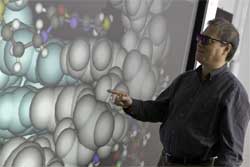
KINGSTON, R.I. – June 21, 2010—University of Rhode Island Pharmacy Professor Bongsup Cho knows there are cancer-causing chemicals in diesel fumes and cigarette smoke.
The biomedical scientist also knows that some of the same chemicals are found in the gooey tar balls that are being produced as a result of the oil spill in the Gulf of Mexico, which began April 20 when a rig exploded and caught fire.
But what he and other scientists have little knowledge of is the long-range impact of the spill on humans and wildlife at the cellular level.
Cho studies the effects of environmental toxins such as cigarette smoke, diesel fumes and charred meat on DNA mutation as potential triggers for cancer.
For close to 20 years, the National Institutes of Health and the American Cancer Society have funded Cho’s research on mechanistic understanding of DNA damage and its consequences on mutation and repair. “Such research is crucial in the development of effective strategies for chemoprevention and drug development, as well as risk assessment,” he said.
Cho said the saturated hydrocarbons found in crude oil, such as methane, hexane and octane, evaporate quickly once in the ocean because they have low boiling points.
“These are the chemicals that can cause the respiratory problems in people involved in cleanup operations, but they are not the ones necessarily known as carcinogens,” Cho said.
In many cases, these volatile organic compounds evaporate quickly when exposed to sunlight and heat. “Most would evaporate before people would suffer effects from them,” Cho said.
But the tar balls and remaining thick ooze washing ashore and into marshes cause more worry for Cho.
“The tar balls contain the non-volatile, benzene-like, heavily unsaturated hydrocarbons with high boiling points,” Cho said. “That’s where there are a lot of toxins, such as benzo[a]pyrene. This is a known human carcinogen, and it is used as a biomarker to detect human exposure to toxins.”
The researcher said a carcinogen usually has mutagenic and teratogenic effects on cells, meaning it can cause mutations in DNA and cause birth defects.
A study of the blood of individuals who worked on the Exxon Valdez cleanup following the spill in March of 1989 found DNA damage in those subjects. “DNA damage in certain functionally important areas of the genome can be a precursor to various human cancers,” Cho said.
While individuals can get sick when volatile organic compounds evaporate, they would have to absorb the non-volatile compounds through ingestion or actual physical contact, he added.
“It has been reported that the size of the Gulf oil spill is unprecedented, much greater than that of the the (land mass) of New England area combined. You have to wonder about the fate of the crude oil that has not come ashore and recovered and what long term effects such toxins will have on the food chain,” Cho said. “The pollutants from these toxins are going to be there for a long time.”
Cho is worried about another phenomena from the spill– the orange sheen seen on the surface of the gulf.
“That orange sheen is a result of a chemical reaction involving the sun, the crude oil and the oil dispersants,” Cho said. “But nobody knows what’s in that color and how toxic the chemicals are. Companies keep the chemical makeup of the dispersants secret.
“Crude oil, like diesel fuel and cigarette smoke, contain thousands of chemicals, and we have studied only a few, so the big worry is the unknown activity of those chemicals we have not studied. According to the recent Cancer Advisory Board report to President Barack Obama, Americans are constantly exposed to chemicals. There are 80,000 of them, and we only know a little about them.
Media Contact: Dave Lavallee, 401-874-5862

